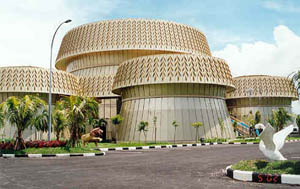
Labuan, officially the Federal Territory of Labuan, is an island federal territory of Malaysia. Its territory includes Labuan Island and six smaller islands, off the coast of the state of Sabah in East Malaysia. Labuan's capital is Victoria and is best known as an offshore financial centre offering international financial and business services via Labuan IBFC since 1990 as well as being an offshore support hub for deepwater oil and gas activities in the region. It is also a tourist destination for people travelling through Sabah, nearby Bruneians and scuba divers. The name Labuan derives from the Malay word labuhan which means harbour.

The Jelebu District is the second largest district in Negeri Sembilan, Malaysia after Jempol, with a population over 40,000. Jelebu borders on the Seremban District to its west and Kuala Pilah District to its south, Jempol District to its southeast, Bentong and Bera Districts, Pahang to its east and Hulu Langat District, Selangor to the north. Jelebu is a suburban district with blossoming semi-agricultural industry. Jelebu is also a parliamentary constituency of the Dewan Rakyat in the Malaysian Parliament. Kuala Klawang is the principal town of the district.

Lawas is a small town and the capital of Lawas District, Limbang Division, Sarawak, Malaysia. This district area is 3,811.90 square kilometres, and population was 46,200. It is 1,200 km from the state capital, Kuching and 200 km from the capital city of Sabah, Kota Kinabalu.

The Borneo Post, established in 1978, is the largest and widely circulated English-language daily newspaper in East Malaysia and also the alternately circulated newspaper in Brunei. The newspaper is the first English newspaper in East Malaysia to use photo-composition for type-setting and printing was done in offset as against the old-fashioned letterpress.

The Sabah Museum is the state museum of Sabah, Malaysia. It is sited on 17 hectares of land at Bukit Istana Lama in Kota Kinabalu, the state capital.

The Malay Technology Museum is a museum in Kota Batu, a historical area in Bandar Seri Begawan, Brunei. It was opened in 1988 and contains exhibits on the traditional technologies used by the indigenous people of Brunei.

Malacca Literature Museum is a museum about Malaysian literary works in Malacca City, Malacca, Malaysia, which resembles the structural design of a residence and was officiated by Chief Minister Mohd Zin Abdul Ghani in 1984.

St. Paul's Hill is a hill in Malacca City, Malacca, Malaysia. It was originally known as the Malacca Hill during the Malacca Sultanate period and Mary's Hill during the Portuguese Malacca period.

Malacca Al-Quran Museum is a museum about Quran in Malacca City, Malacca, Malaysia, which was developed with the cooperation between Restu Foundation and Malacca State Government and opened to the public on 10 January 2008. It is located next to the state mosque of Malacca and consists of 12 main halls and a shop.

The Aborigines Museum is a museum in Ayer Keroh, Malacca, Malaysia, which showcases the native people relics found in the country. It was originally located inside Ayer Keroh Recreational Forest, but later relocated to its present area along Lebuh Ayer Keroh in December 1996 and went under the management of Malacca Museum Corporation. The museum was reopened on 3 February 1997.

The Paddy Museum is a museum in Alor Setar, Kota Setar, Kedah, Malaysia.

The Petaling Jaya Museum is a museum in Petaling Jaya, Petaling District, Selangor, Malaysia. It showcases the history and the development of Petaling Jaya.

The Customs Museum is a museum in Kuala Klawang, Jelebu District, Negeri Sembilan, Malaysia, which exhibits facets and lifestyle of the Malaysian people and identity of Negeri Sembilan. It was constructed in 2005 and officially opened on 2 February 2008 by Negeri Sembilan Chief Minister Mohamad Hasan and Minister for Culture, Arts and Heritage Rais Yatim. The museum is housed in a four-story building, with a giant replica of Malay headdress at the top of its entrance and consists of four galleries which are: Introduction of custom, Life cycle, Intellectual tradition, government and power and Pepatih customs.

The Labuan Museum is a museum located along Jalan Dewan in central Labuan, Malaysia.

The Islamic Heritage Museum is a museum in Kuching, Sarawak, Malaysia. It is part of the Kuching Heritage Trail.

The Darul Ridzuan Museum is a museum in Ipoh, Kinta District, Perak, Malaysia.
Tun Sakaran Museum is a museum in Semporna of Sabah, Malaysia. It is named after the 8th Yang di-Pertua Negeri of Sabah, Sakaran Dandai.
Muzium Mat Sator is a museum in Old Kapayan Village in Tambunan District of Sabah, Malaysia. It is named after the follower and chief lieutenant of Mat Salleh, Mat Sator. The museum is located around 122-metre from the area of the Fort of Mat Salleh.



















